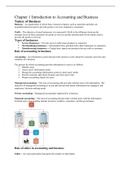Samenvatting
Financial Management Summary Block 1
Chapter 1 Introduction to Accounting and Business Chapter 2 Analyzing Transactions Chapter 3 The Adjusting Process Chart of Accounts (accounts per classification, with definition) This summary contains everything from the theory you need to know for your Financial Management Exam. With th...
[Meer zien]




